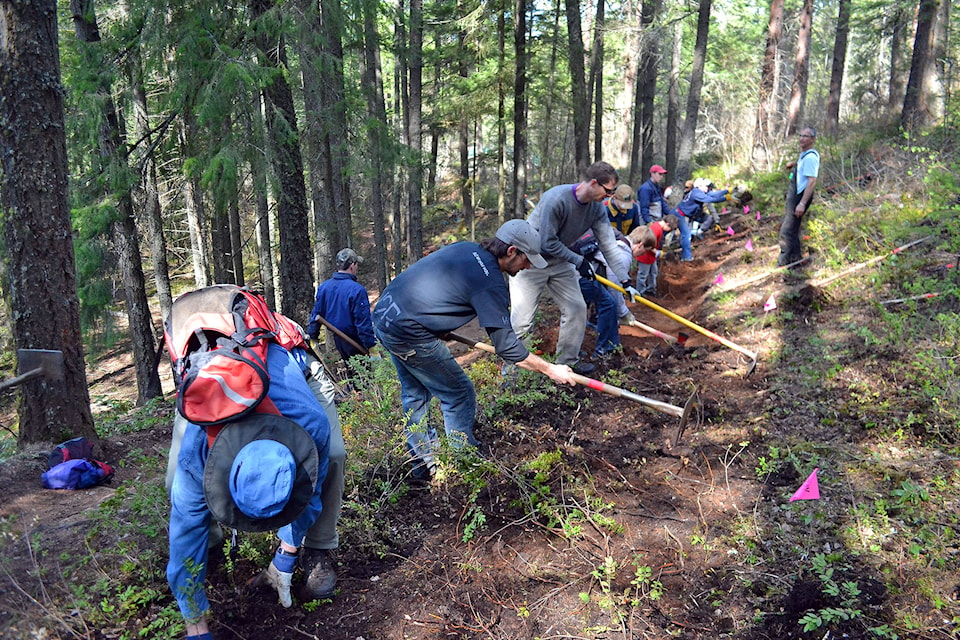By Jim Cooperman
Contributor
In just 15 years, the Shuswap Trail Alliance has grown from a small group of volunteers to become one of the most important organizations in our community that has invested nearly $5.5-million of grants, donations and in-kind services to construct 143 kilometres of new trails.
The key to this non-profit’s success is its dedication to collaboration, as it has involved nearly every group that has an interest in the recreational use of local public lands.
When Shuswap Trail Alliance executive director Phil McIntyre-Paul first arrived in the Shuswap in 1996 to work at the Sorrento Centre, one of his jobs was to organize group day hikes. He initially joined an ambitious group to create hut-to-hut trails to link the Shuswap with the Okanagan. When that vision faded, a larger effort began when regional stakeholders met in 2004 to consider a proposal to create an internationally recognized trail and waterway network.
The first step was the formation of an advisory group with representation from local governments, First Nations, economic and tourism groups, recreation organizations and other associations. After a yearlong study to examine the viability of the vision and determine how communities and groups could work together to develop a system of trails and waterway routes, the Trail Alliance was formally incorporated as a non-profit society in November 2005.
After a year of planning, the first Shuswap Trail Strategy was developed that proposed an ambitious five-year program that would link existing plans with new ones to create a unified vision of active, healthy communities with a commitment to stewardship and ecological integrity, respect for First Nation values and heritage and ongoing consultations and partnerships.
By 2010, the Trail Alliance had become the focal point for regional trail development and management leadership with many successes including a standards manual of best practices for trail design, commitment for unified signage standards, training programs, a dedicated volunteer base, partnerships with local government for new trails, the identification of over 300 kilometres of proposed trails and greenway corridors and the construction of over 50 kms of new trails.
Read more: Greeting card sales support Sicamous to Armstrong rail trail project
Read more: Column: The Shuswap is a staycation paradise with plenty to discover
When the trail strategy was updated in 2015, one of the outcomes was the creation of a roundtable that would provide opportunities for a larger, more diverse group that includes the motorized recreation sector to help guide future trail planning and use. Meeting yearly, with a working group that meet quarterly, the Shuswap Regional Trails Roundtable works with all levels of government, and Secwepemc representatives to provide strategic, collaborative direction, feedback and participation in the many trail initiatives now underway.
One of the Trail Alliance’s major achievements was helping the Shuswap North Okanagan Rail Trail project between Sicamous and Armstrong to move forward, including initial project management and planning. It then helped launch a new committee that will help promote the project and raise funds for the construction.
Key partners for trail development include the municipalities and regional districts that fund and maintain trails, and Rec Sites and Trails BC, which oversees all recreational use of Crown land and supervises site maintenance. As well, the Trail Alliance works with BC Parks to help them plan, maintain and build trails. Respect for Secwepemc values and interests guide all projects under the overall theme, to Take Care of the Land (Y’icwetsutce) and Secwepemc leaders from all four Shuswap Lakes bands provide direction.
We can all look forward to a future filled with opportunities for nature based recreation, thanks to the Trail Alliance’s dedication to its vision of “establishing the entire Shuswap watershed as a united destination centre known for its active lifestyle, vibrant culture, natural beauty and commitment to ecological sustainability.”
The pandemic revealed the importance of investing in outdoor recreational infrastructure because many of us depended on enjoying the trails to keep fit and stay healthy when the indoor recreational services were closed.
